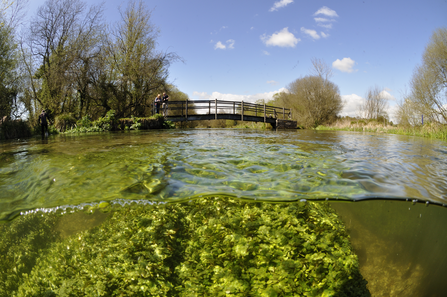In the past these little mammals were a common presence in our rivers and streams, a familiar plop heard as they dropped into the water or a fleeting glimpse of them feeding on the banks. However, water vole populations have undergone severe declines since the early 1940s, and have disappeared from around 90% of the places they once lived. But why have water voles declined so much? The British Isles are wet places, seemingly with plenty of habitat for them and they are herbivores, eating grass and stems which grow abundantly around waterways – here we cover some of the things that went wrong for the water vole.
Intensification
After the second World War farming intensified, leading to an increase in run-off pollution, trampling of banks during heavy grazing by cattle and the destruction of many river habitats to make way for agriculture. River channels were straightened, banks had their vegetation removed and land was parcelled up, all leading to the destruction and fragmentation of water vole’s homes.
Nature reserves became some of the only places you could find water voles and here in Hampshire and the Isle of Wight we are lucky enough to have strong populations in certain areas. For example, at Winnall Moors just outside Winchester water voles have healthy populations as the banks are protected and no dogs are allowed in the nature reserve to disturb them.
Water pollution
In 2020 shocking reports revealed that every single river in England is polluted beyond legal limits. This pollution comes from various sources, but the major causes are farming and sewage, with run-off from urban areas and leaching from old mines and landfills among the other causes. River ecosystems are under threat from this pollution, water voles among them.
The situation is not being addressed with the urgency it clearly deserves. This month campaigners have shown that legislation which should be reducing agricultural pollution is extremely weak, with no prosecutions or fines despite regular breaches and pollution incidents since new rules were drafted in 2013.
To help water voles, and other creatures that depend on clean water, the government must commit to strong environmental legislation and funding to ensure regulatory bodies can enforce these rules. The Environment Bill this autumn will be a chance for the government to deal with sewage pollution and install better regulations for our rivers.
Invaders
In the 1950s and onwards, water vole populations took another hit as American mink escaped from fur farms. Mink are well-adapted predators and their flexible bodies mean they can fit into water vole burrows, but they also predate ground-nesting birds, particularly wading species like lapwing. In some areas the problem is so severe that mink control takes place, removing this non-native threat from our waterways. Non-native invasive species are often a particular threat to species which are already in decline, as the added pressure tips fragile populations over the edge.
Helping water voles
The Trust is helping water vole populations in our two counties in a number of ways. These include reintroductions, coordinating national projects and managing our nature reserves with water voles (and other declining freshwater species) in mind.
Thousands of water voles were released in 2013 in two Trust sites in the Meon Valley, they are now established in the river and the populations are thriving.
The Trust deliver the National Water Vole Database and Mapping Project , bringing together data on mink and water voles in Britain. While their distribution is still nowhere close to what it was in the past, work by us and other Trusts has begun to reverse the fortunes of these charismatic rodents. By mapping where water voles and their threats are present Trusts can better plan projects to help the voles and focus efforts for a nature recovery network.


